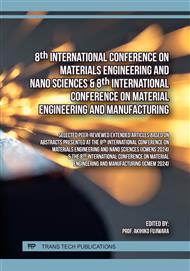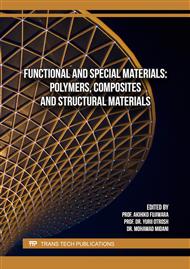[1]
M.I. Ahmad, Y. Li, J. Pan, F. Liu, H. Dai, Y. Fu, T. Huang, S. Farooq and H. Zhang, Collagen and gelatin: Structure, properties, and applications in food industry, Int. J. Biol. Macromol. 254 (2024), 128037.
DOI: 10.1016/j.ijbiomac.2023.128037
Google Scholar
[2]
W. Zhang, M. Azizi-Lalabadi, S. Jafarzadeh and S.M. Jafari, Starch-gelatin blend films: A promising approach for high-performance degradable food packaging, Carbohyd. Polym. 320 (2023), 121266.
DOI: 10.1016/j.carbpol.2023.121266
Google Scholar
[3]
S. Mohanto, S. Narayana, K.P. Merai, J.A. Kumar, A. Bhunia, U. Hani, A.A. Fatease, B.H.J. Gowda, S. Nag, M.G. Ahmed, K. Paul and L.K. Vora, Advancements in gelatin-based hydrogel systems for biomedical applications: a state-of-the-art review, Int. J. Biol. Macromol. 253 (2023), 127143.
DOI: 10.1016/j.ijbiomac.2023.127143
Google Scholar
[4]
C. Morrish, S. Teimouri and S. Kasapis, tructural manipulation of the gelatin/genipin network to inform the molecular transport of caffeine, Food Hydrocolloid. 140 (2023), 108616.
DOI: 10.1016/j.foodhyd.2023.108616
Google Scholar
[5]
S. Yang, Y. Zhang, T. Wang, W. Sun and Z. Tong, Ultrafast and programmable shape memory hydrogel of gelatin soaked in tannic acid solution, ACS Appl. Mater. Inter. 12 (2020), 46701-46709.
DOI: 10.1021/acsami.0c13531
Google Scholar
[6]
L. Pan, J. Du, Q. Yin, Y. Tao and P. Li, Tannic acid adsorption properties of cellulose nanocrystalline/fish swim bladder gelatin composite sponge, Int. J. Biol. Macromol. 257 (2024), 128552.
DOI: 10.1016/j.ijbiomac.2023.128552
Google Scholar
[7]
S. Taokaew, S. Seetabhawang, P. Siripong and M. Phisalaphong, Biosynthesis and Characterization of Nanocellulose-Gelatin Films, Materials. 6 (2013), 782.
DOI: 10.3390/ma6030782
Google Scholar
[8]
N. Thongsrikhem, S. Taokaew, M. Sriariyanun and S. Kirdponpattara, Antibacterial activity in gelatin-bacterial cellulose composite film by thermally crosslinking with cinnamaldehyde towards food packaging application, Food Packag. Shelf Life. 31 (2022), 100766.
DOI: 10.1016/j.fpsl.2021.100766
Google Scholar
[9]
Z.N. Hanani, J.A. O'Mahony, Y.H. Oliveira and J.P. Kerry, Extrusion of gelatin-based composite films: Effects of processing temperature and pH of film forming solution on mechanical and barrier properties of manufactured films, Food Packag Shelf Life. 2 (2014), 91.
DOI: 10.1016/j.fpsl.2014.09.001
Google Scholar
[10]
Ratna, C. Ulfariati, Yusmanizar, S. Aprilia, Rahmiati and A.A. Munawar, Development of biocomposite edible film food packaging based on gelatin from chicken claw waste, Case Stud. Chem. Environ. Eng. 8 (2023), 100371.
DOI: 10.1016/j.cscee.2023.100371
Google Scholar
[11]
A.A. Al-Hassan and M.H. Norziah, Starch–gelatin edible films: Water vapor permeability and mechanical properties as affected by plasticizers, Food Hydrocolloid. 26 (2012), 108.
DOI: 10.1016/j.foodhyd.2011.04.015
Google Scholar
[12]
M. Easdani, S. Ahammed, M.N. Saqib, F. Liu and F. Zhong, Engineering biodegradable controlled gelatin-zein bilayer film with improved mechanical strength and flexibility, Food Hydrocolloid. 148 (2024), 109430.
DOI: 10.1016/j.foodhyd.2023.109430
Google Scholar
[13]
A. Phumkacha, T. Leejarkpai and S. Kirdponpattara, Effects of Plasticizers on Physical and Mechanical Properties of Tamarind Kernel Powder Film, Mater. Sci. Forum. 1098 (2023), 65.
DOI: 10.4028/p-nbii0n
Google Scholar
[14]
N. Cao, X. Yang and Y. Fu, Effects of various plasticizers on mechanical and water vapor barrier properties of gelatin films, Food Hydrocolloid. 23 (2009), 729-735.
DOI: 10.1016/j.foodhyd.2008.07.017
Google Scholar
[15]
J.W. Park, W.S. Whiteside and S.Y. Cho, Mechanical and water vapor barrier properties of extruded and heat-pressed gelatin film, LWT-Food Sci. Technol. 41 (2008), 692-700.
DOI: 10.1016/j.lwt.2007.04.015
Google Scholar
[16]
P.J.A. Sobral, F.C. Menegalli, M.D. Hubinger and M.A. Roques, Mechanical, water vapor barrier and thermal properties of gelatin based edible films, Food Hydrocolloid. 15 (2001), 423-432.
DOI: 10.1016/s0268-005x(01)00061-3
Google Scholar
[17]
N. Suderman, M.I.N. Isa and N.M. Sarbon, The effect of plasticizers on the functional properties of biodegradable gelatin-based film: A review, Food Bioscience. 24 (2018), 111-119.
DOI: 10.1016/j.fbio.2018.06.006
Google Scholar
[18]
S. Kirdponpattara, M. Phisalaphong and S. Kongruang, Gelatin-bacterial cellulose composite sponges thermally cross-linked with glucose for tissue engineering applications, Carbohyd. Polym. 177 (2017), 361-368.
DOI: 10.1016/j.carbpol.2017.08.094
Google Scholar
[19]
Khairuddin, E. Pramono, S.B. Utomo, V. Wulandari, A. Zahrotul W and F. Clegg, FTIR studies on the effect of concentration of polyethylene glycol on polimerization of Shellac, J. Phys. 776 (2016), 012053.
DOI: 10.1088/1742-6596/776/1/012053
Google Scholar
[20]
P. Wang, H. He, R. Cai, G. Tao, M. Yang, H. Zuo, A. Umar and Y. Wang, Cross-linking of dialdehyde carboxymethyl cellulose with silk sericin to reinforce sericin film for potential biomedical application, Carbohyd. Polym. 212 (2019), 403-411.
DOI: 10.1016/j.carbpol.2019.02.069
Google Scholar
[21]
N, Maftoonazad, H.S. Ramaswamy and M. Marcotte, Application and Evaluation of a Pectin-Based Edible Coating Process for Quality Change Kinetics and Shelf-Life Extension of Lime Fruit (Citrus aurantifolium), J. Food Process. Eng. 30 (2007), 539-563.
DOI: 10.3390/coatings9050285
Google Scholar
[22]
W.A. Asfaw, K.D. Tafa and N. Satheesh, Optimization of citron peel pectin and glycerol concentration in the production of edible film using response surface methodology, Heliyon. 9 (2023), e13724.
DOI: 10.1016/j.heliyon.2023.e13724
Google Scholar
[23]
P. Hernandez-Munoz, R. Villalobos and A. Chiralt, Effect of cross-linking using aldehydes on properties of glutenin-rich films, Food Hydrocolloid. 18 (2004), 403-411.
DOI: 10.1016/s0268-005x(03)00128-0
Google Scholar
[24]
J. Park, J. Nam, H. Yun, H.-J. Jin and H.W. Kwak, Aquatic polymer-based edible films of fish gelatin crosslinked with alginate dialdehyde having enhanced physicochemical properties, Carbohyd. Polym. 254 (2021), 117317.
DOI: 10.1016/j.carbpol.2020.117317
Google Scholar



